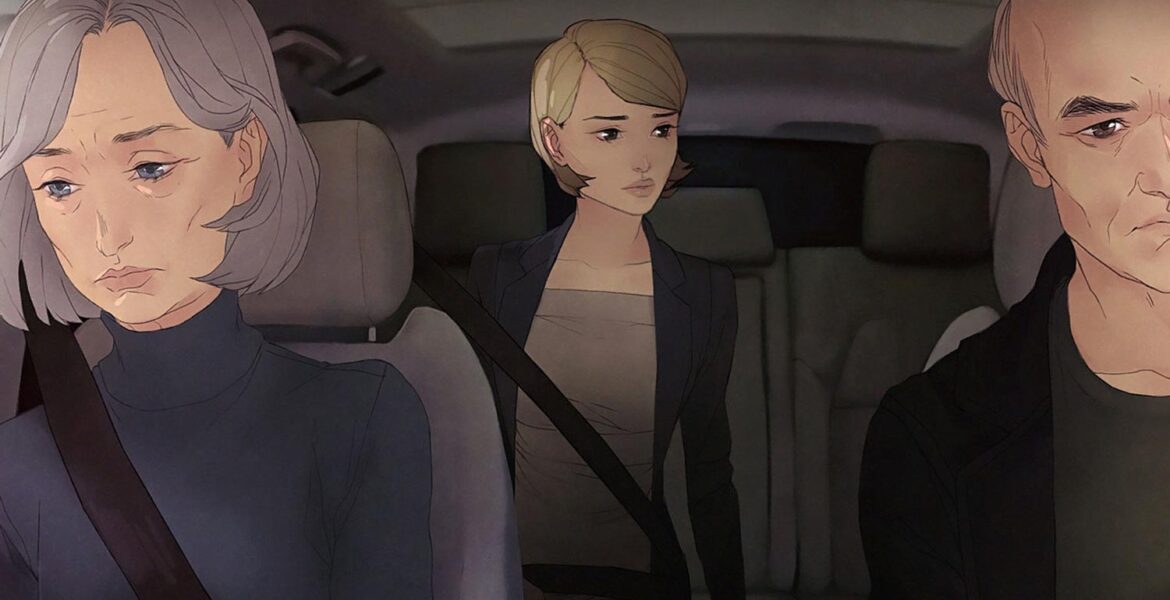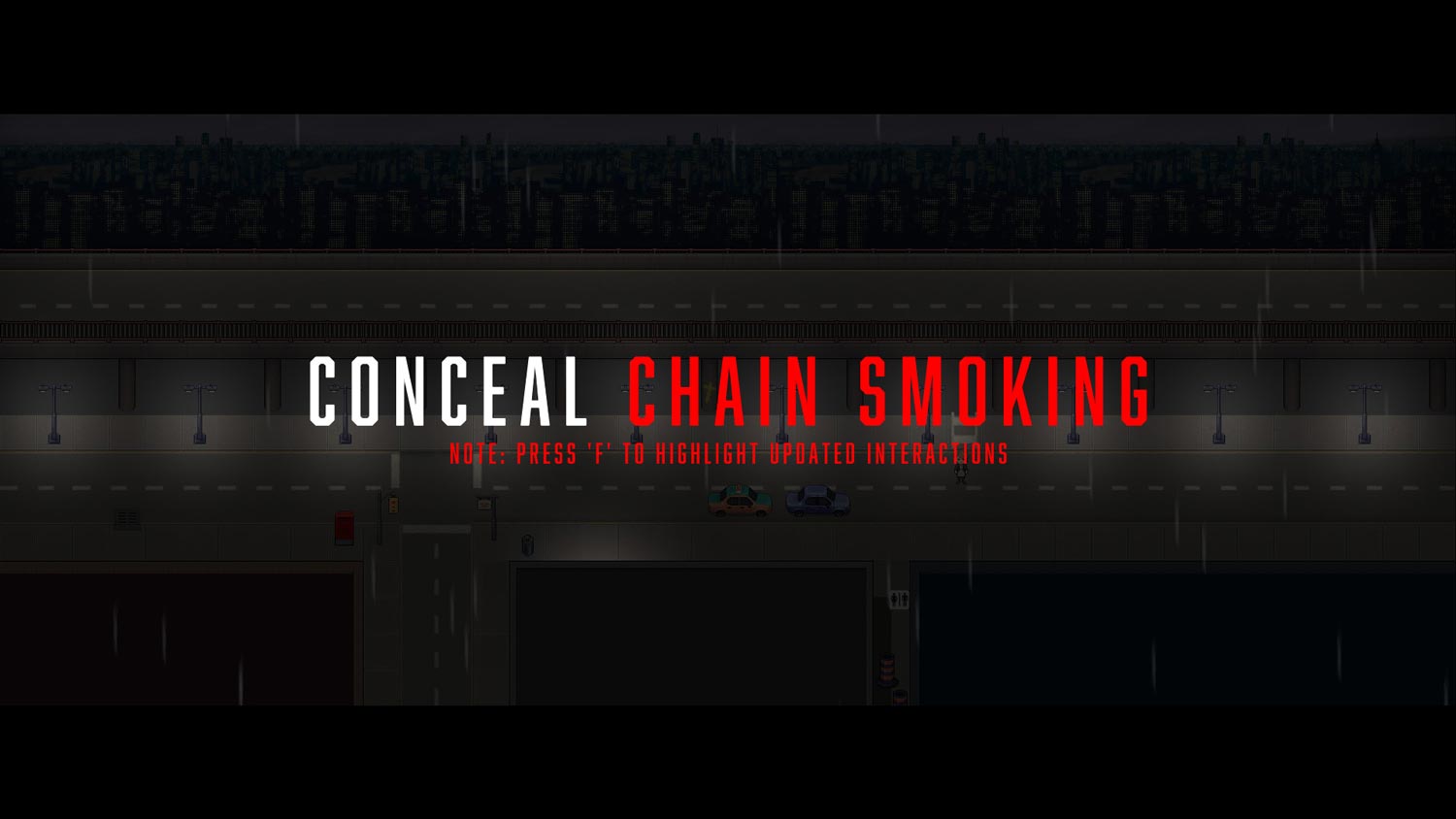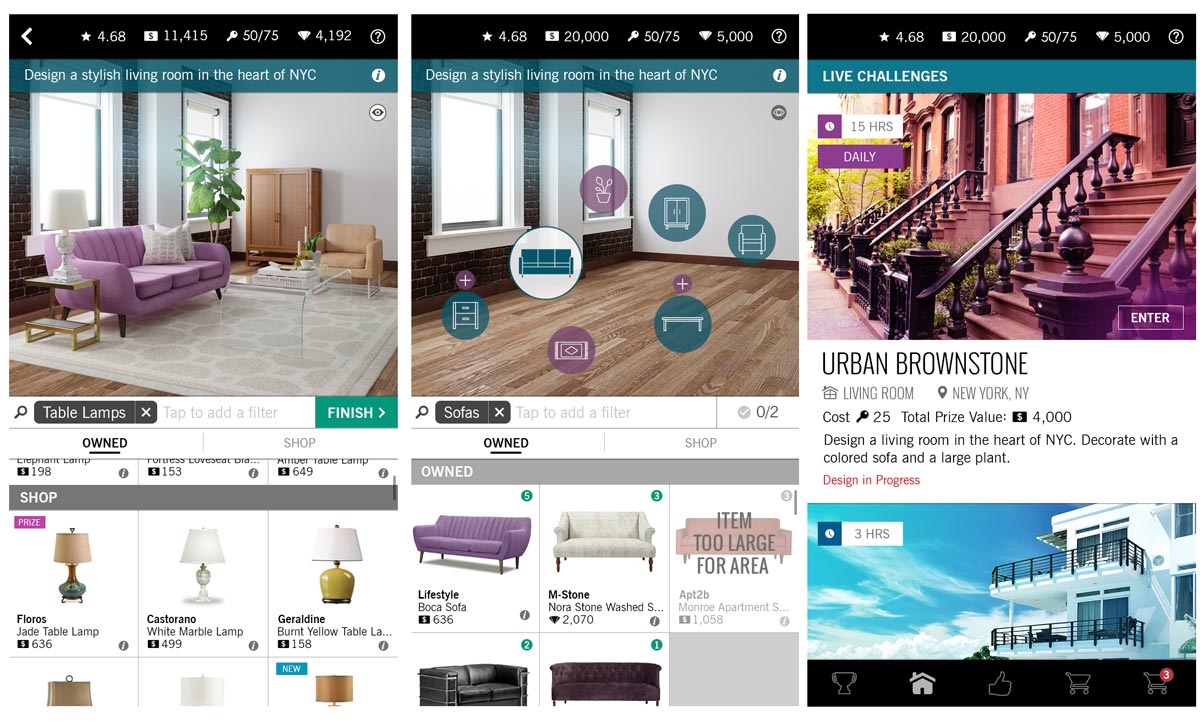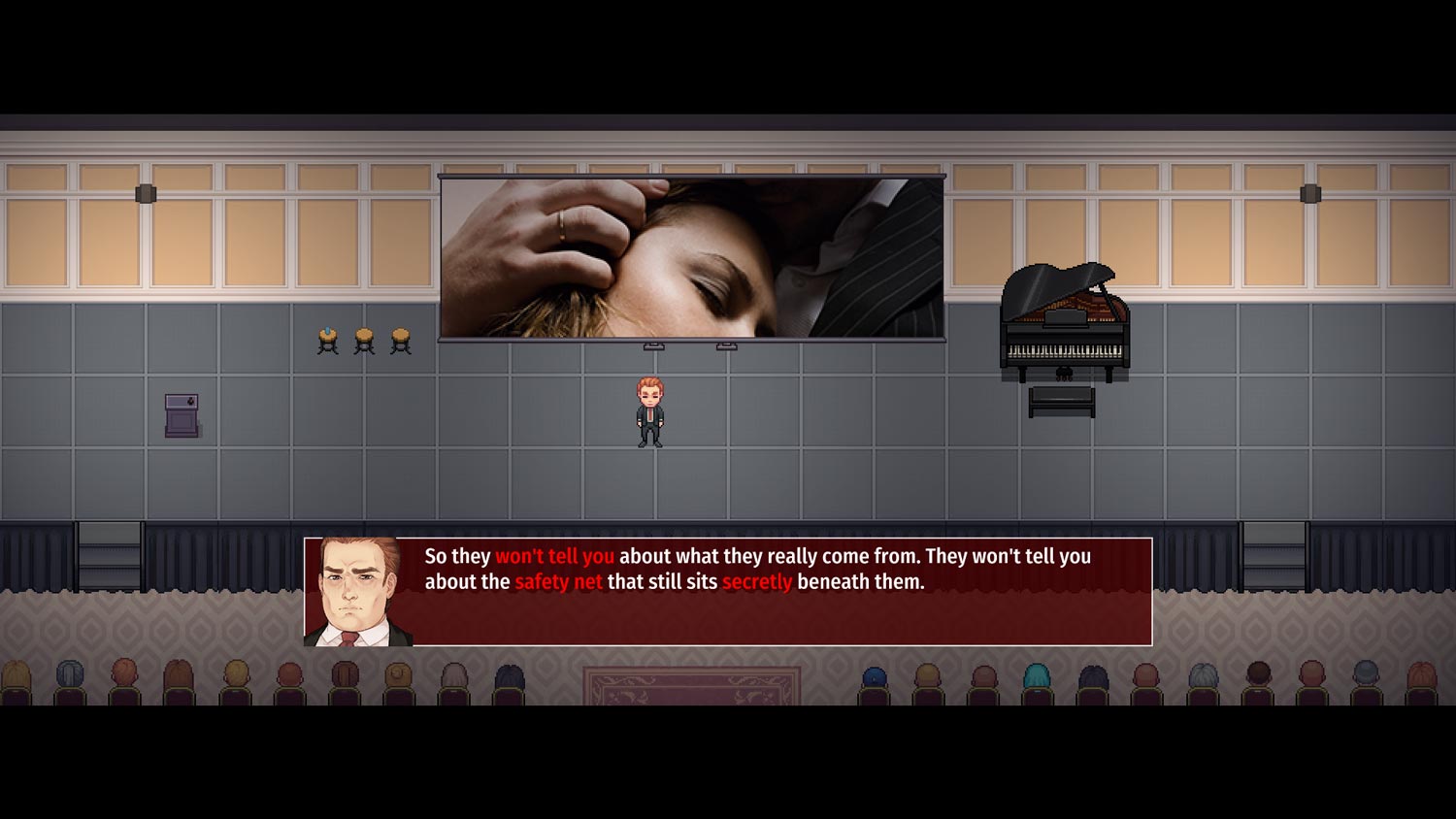
The economic dread of Little Red Lie and Design Home
This is one of a few pieces on this site rescued from the digital scrapheap, originally published for a site that’s no longer online. I’ll begrudgingly remove if any shadowy publishing types compel me to relinquish what’s rightfully theirs, despite having unceremoniously binned it themselves, but come on. That’d just be silly.
It’s presented as is, so you’ll have to forgive any outdated references or generally shoddy writing.
–
I’m not going to lie: the entire premise of this article is based on a coincidence.
Of all the millions of games available on the iOS App Store, the two I found myself downloading one week in August were Little Red Lie and Design Home. Little Red Lie is a text-heavy narrative game, brought to iOS after launching first on Steam, which examines the various ways in which a cycle of economic insecurity can gradually grind out the hope and soul of a person. Design Home, by contrast, is a free-to-play interior design app in which you buy $3,000 coffee tables using virtual cash to decorate swanky Manhattan loft apartments.
Each appealed to me for very different reasons. Little Red Lie was designed by Will O’Neill, the writer and game designer whose previous release, Actual Sunlight, I had loved. Confident I’d get a thoughtfully-designed experience of the kitchen sink variety, and keen to support O’Neill, I happily forked over $4.99 to buy it. Conversely, when it came to the free-to-play Design Home, I had my professional hat on, looking to better understand why it was making so much money through in-app purchases.
These weren’t two games that I expected to discover many parallels between, yet I found that both provoked within me the exact same feeling.

Little Red Lie, like Actual Sunlight before it, delivers a bleak gut-punch that’s all the more potent because it is not fantastical in the slightest. The main — or at least most sympathetic — character in Little Red Lie is Sarah Stone, a woman in her late thirties who is concealing a number of personal details from her parents and the other people in her life. This begins small, with her hiding a smoking habit, but it is quickly revealed that she has secretly sold the apartment she once owned, is spiralling into debt, and that every day she goes out to maintain the illusion of employment at a company that let her go weeks earlier. She lives with her elderly parents in the house she grew up in, sleeping in her childhood bedroom, where she feels simultaneously at home and distinctly out of place.
The other playable character, Arthur Fox, is a man of similar age to Sarah Stone, who also lives in Toronto, but represents the other end of the financial power spectrum. He’s a wealthy motivational speaker who feeds platitudes to struggling people about how a little more application and self-belief can help them claw their way to solvency, holding the poor in utter contempt while building a lucrative career on their backs. What binds these two characters are their relentless lies, highlighted in red throughout the game. Arthur lies to build and maintain his status, while Sarah lies to hide how bad things have truly become.
The big lie at the heart of Design Home is that it lets you actually, well, Design Homes. The reality is that the player selects which sofas, rugs, or coffee tables should be slotted into a pre-designed room arrangement, with no actual power over the positioning and layout of the furniture. This means that the game, inasmuch as it can be called one, consists of nothing more than browsing a catalogue of virtual furniture — all of which is based on real-world brands, and includes a link to purchase its physical counterpart — before buying it using virtual currency and putting it in an attractive virtual space. This, in combination, feeds the fantasy that you’ve got a natural eye for design by making it very difficult to create a genuine eyesore.

But you can buy more and better furniture by spending real money, which plenty of players have evidently opted to do: Design Home raked in $22.5 million between April and June 2017 alone. Statistics show that millennial homeownership is at an all-time low, and that it’s increasingly common for 25- to 34-year-olds to live with parents or other relatives. I’m frequently gripped with the fear that I’ll never own a home, and even if I do, it sure as hell won’t look like the ones depicted in Design Home. This is what’s so troubling. How many people like me and Sarah Stone, unable to buy real homes, have contributed to this $22.5 million while distracting ourselves by tinkering with pretend ones?
“The entire mobile games marketplace is kind of a dark space economically,” Little Red Lie creator Will O’Neill tells me in our interview. “We know so much about how data scientists are the real driving force behind those games and not creative game developers. We know that the cost of user acquisition is very high, that they chase whales — people with more money than [reasoning], or who have addictive personalities.”
O’Neill continues, “The odd thing is that Little Red Lie is kind of really about the economic doom of Sarah Stone, but if you look at the mobile space, the person who would get caught up in those games would be Arthur Fox, not her.”
Perhaps he’s right about that. I hope so, at least. But while the Sarah Stones of this world don’t have the means to spend big on virtual armchairs like the Arthur Foxes, there’s something darkly timely about the rise of property-based escapism while housing is at its least accessible in modern history. The main parallel between Little Red Lie and Design Home, then, is that both essentially tackle the same issue in different ways: Little Red Lie confronts, while Design Home distracts.

“I’m absolutely from the artistic school of thought that art should be confrontational, more so than entertainment and escapism,” says O’Neill. “It’s an aspect of games that is kind of deficient, because there is a large contingent of people who don’t believe that this kind of art has any place within the medium; that there’s something about it that is just intrinsically tied to escapism. And I really couldn’t disagree more. All the things about games — the interactivity, the walking in somebody’s shoes — that make it so powerful for escapism [also]make it just as powerful a medium for confrontation.”
Little Red Lie does this brilliantly: every false social nicety or half-heartedly optimistic inner monologue inked in red forces us to acknowledge how little is left when we strip away our ingrained dishonesty. It reveals how our economic standing controls every aspect of our lives, including the lies we tell. It would be emotionally exhausting if every game were to be as confronting as this, and escapism is something there’s obviously room for, but O’Neill believes some forms of it are more dangerous than others.
“The type of escapism I think you’re exploring with the housing pornography games [like Design Home], or even I’d say with some of the dating sims, is a little darker,” he argues. “They’re attempting to be a mode of escapism from something that’s actually hurtful to people in real life. People are actually distraught that they don’t have adequate housing; that they’ll never own anything they consider to be valuable or beautiful. In the same way, any dating sim that has in-app purchases is to a certain extent exploiting people who are lonely and long for relationships. The twisted part is, depending on how you’re willing to comprehend it, that’s a mode of confrontation as well — it’s just that it’s trying to get you to look past it and spend money.”

The fact that Design Home, and games like it, are based around such “grown-up concerns” is also disconcerting for O’Neill.
“We talk like, ‘oh, games have grown up and players have grown up with them.’ They sure have, and if anything we’re seeing evidence of how little people’s lives have progressed because now they’ve gone from longing for fantasy battles, to longing for the most fashionable clothes, to longing for a place to lay their head. What’s next: food, or water?”
While I’d stop short of calling myself an advocate for them, I’ve never quite been able to fathom the deep hatred that many feel for free-to-play games. My stance is that, as with all games, there are good and bad ones. But while far more egregious examples exist, Design Home is the first time that I’ve been made to feel so uneasy about how a game makes its money. I keep wondering when the spell might break for a paying player. When does what began as escapism become confronting; the guilty pleasure becoming an emblem of all the very real problems in their life?
We all lie to ourselves, and sometimes we pay others to help us do so. It’s easy, and at times it would be unbearable not to. But while Will O’Neill’s refusal to stop confronting truths with Little Red Lie makes it an utterly punishing experience, it has the effect of making the player also drop their guard. We see true feelings skirted around in much the same way we would do ourselves, familiar anxieties aired in unguarded moments, and are forced to concede that perhaps we have some things in common with Arthur Fox as well as Sarah Stone. It may lack the dim satisfaction of placing a (digital) shiny vase atop a (digital) designer cabinet, grasping at but failing to scratch the itch within you for something real, but Little Red Lie has more to say about our current financial situation than any game I’ve ever played.
